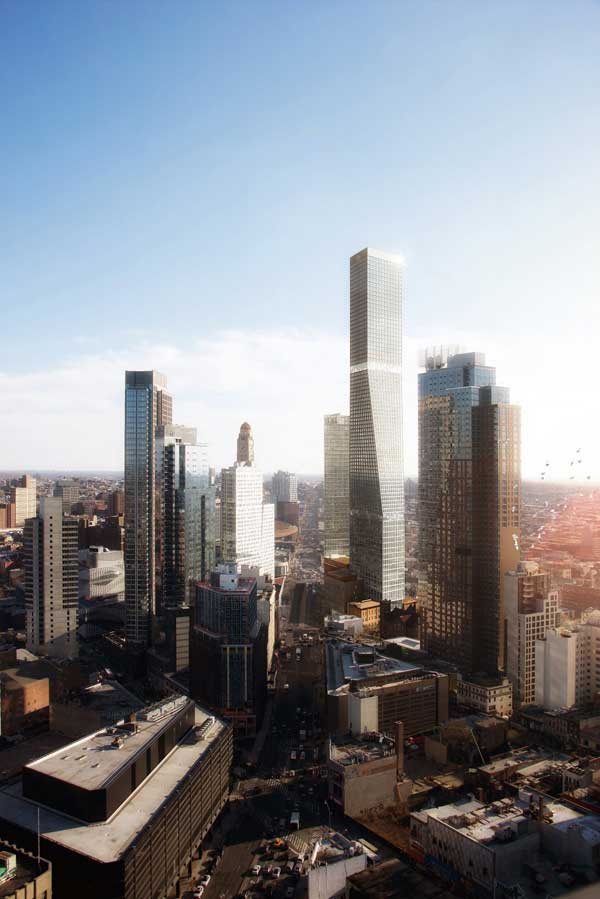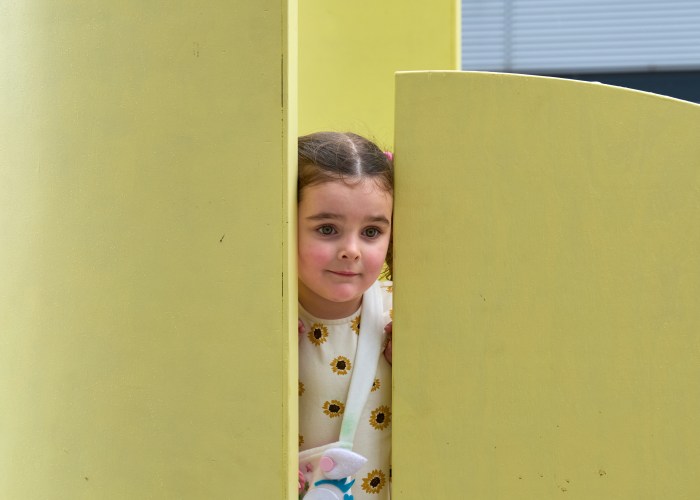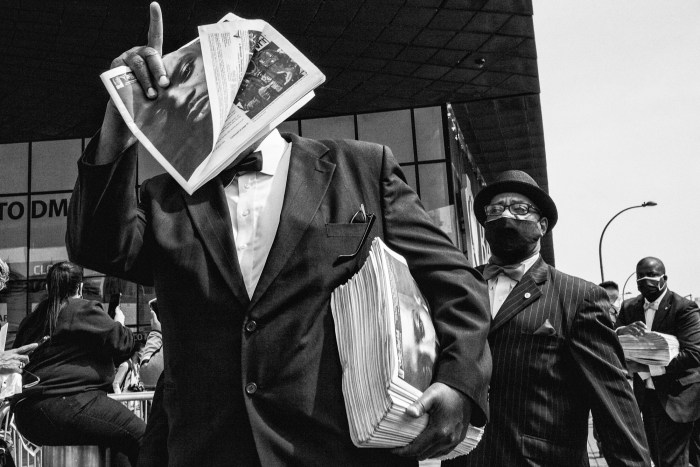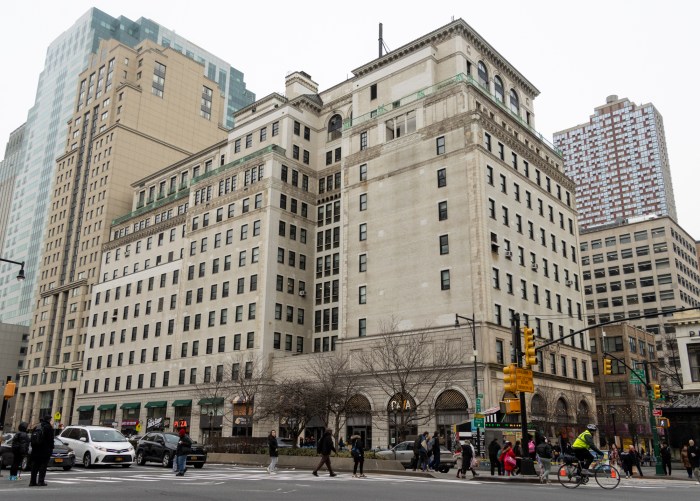Whose backyard is it anyway?
The massive 74- and 38-story towers in a controversial megadevelopment planned for the edge of Boerum Hill have no place in the brownstone-lined neighborhood, locals fiercely opposed to the project have argued since it was revealed more than a year ago.
“It’s not too late to recognize how egregious this proposal is for Boerum Hill,” said one critic of the 80 Flatbush complex at the beep’s April 30 hearing on it, following months of similar complaints.
But 80 Flatbush — a five-building scheme on a lot bounded by Flatbush and Third avenues and State and Schermerhorn streets that will contain residential, commercial, cultural, and educational spaces if erected — isn’t in Boerum Hill at all, according to leaders at builder Alloy Development, who claim their project will actually rise in the enclave’s neighbor, the already skyscraper-filled America’s Downtown.
“A growing city should be providing density in the right locations and we think this is one of them,” said Jared Della Valle, a bigwig at Alloy, whose website for 80 Flatbush bills it as “a proposed mixed-use development in Downtown Brooklyn.”
And no matter what neighborhood incorporates the complex, the 80 Flatbush site is within the special Downtown Brooklyn district — where buildings’ size is regulated by density, not height — that city officials formed in 2004 to bring taller, mixed-use structures to the area in an effort to stimulate economic growth.
Still, Alloy can’t break ground until the city signs-off on a rezoning that would nearly triple the site’s allowable “floor-area-ratio,” a measurement that determines how high a structure can be relative to the size of the land it is on, from 6.5 to 18 — a request that Boerum Hill purists return to in order to crucify the project as entirely wrong for the neighborhood.
“There’s no concern for the perpetually told untruth that the development is Downtown, when it is in Boerum Hill,” Fort Greener Lucy Koteen said at an earlier public hearing as part of the Uniform Land Use Review Procedure for 80 Flatbush. “Zoning and neighborhood definitions were put into place to protect neighborhood character.”
Neighborhoods, however, are merely arbitrary monikers established in the last century — often by real-estate agents trying to sell properties, according to the head of a private preservationist group.
“Neighborhoods in New York City are seamlessly elastic and also imprecise,” said Simeon Bankoff, who runs the Historic Districts Council. “Boerum Hill was a new 20th-century creation that was, as I recall, created by realtors to differentiate from Carroll Gardens and Cobble Hill.”
The area now known as Boerum Hill only received its name in 1964, according to a New Yorker report.
And before that, the present-day neighborhood — generally bounded by Schermerhorn Street, Baltic Street, Fourth Avenue, and Court Street — was lumped together with a vast amount of land known as South Brooklyn, which stretched from the banks of the East River to areas today’s locals call Red Hook and Gowanus, according to a Brooklyn Historical Society bigwig.
“The separate names for a lot of the areas that we know as Brownstone Brooklyn are a relatively recent thing,” said Julie Golia. “We don’t have municipality-designated neighborhoods, it’s a little bit of a free market the way we understand them.”
And some Brooklynites remained reluctant to embrace the Boerum Hill moniker years after it was coined, according to the author of “The Invention of Brownstone Brooklyn,” who argued that some locals who led a 1966 protest against the city’s demolition of an abandoned brownstone in the area likely would not have called it by its current name back then.
“Most surely had not heard of Boerum Hill,” Suleiman Osman wrote in his tome. “For most Brooklynites in the 1960s the block was an indistinguishable
part of South Brooklyn.”
In 1973, when city preservationists at the Landmarks Preservation Commission designated a swath of Boerum Hill for protection as a historic district, they set Wyckoff, Hoyt, Pacific, and Nevins streets as its boundaries to create a jagged stretch that included roughly 250 buildings, most of them row houses.
And last October, when the agency kicked-off a process to consider expanding the Boerum Hill Historic District, it proposed extending those boundaries — but not far enough to include the 80 Flatbush site or even its surrounding city blocks.
The fact that present-day Boerum Hill didn’t even exist 60 years ago undermines those arguments against the project that are based solely on its location, according to supporters, who claimed its opponents’ angst boils down to privilege and a bad case of NIMBY or “not in my backyard” thinking.
“It’s incredibly NIMBY — there’s such an emphasis on ‘this is our neighborhood, we don’t want anyone else in it, we want it to ourselves,’ ” said William Thomas, a member of the citywide, pro-development group Open New York, who lives in Manhattan. “What happens in one neighborhood effects another, the idea of shutting yourself off from the rest of the city and trying to keep everyone else out is incredibly unfair.”
Some 80 Flatbush critics, however, argue its polarizing location is secondary to its poor planning, and that the complex containing 900 new apartment units — 200 of which will be so-called affordable housing — on top of new elementary and high-school classrooms doesn’t belong anywhere in the borough as designed.
“I have said it doesn’t matter what neighborhood it’s in,” said Howard Kolins, the president of civic group the Boerum Hill Association, whose website claims the megadevelopment is in Boerum Hill, not Downtown. “We don’t think this development is intelligent development.”
But the project’s proximity to the massive Atlantic Terminal transit hub and its public benefits — including the new schools and below-market-rate apartments — are too important to sacrifice to a debate over its neighborhood, according to a bigwig at an organization that promotes economic and environmental stability through urban research and planning.
“I don’t think it’s important whether you call this particular site Downtown, Boerum Hill, Flatbush, or even Fort Greene,” said Moses Gates, who works for the Regional Plan Association. “This is the kind of place where these developments should go — it’s in line with more or less the rest of Downtown Brooklyn, and in line with the type of density we should be bringing around major transit hubs.”























